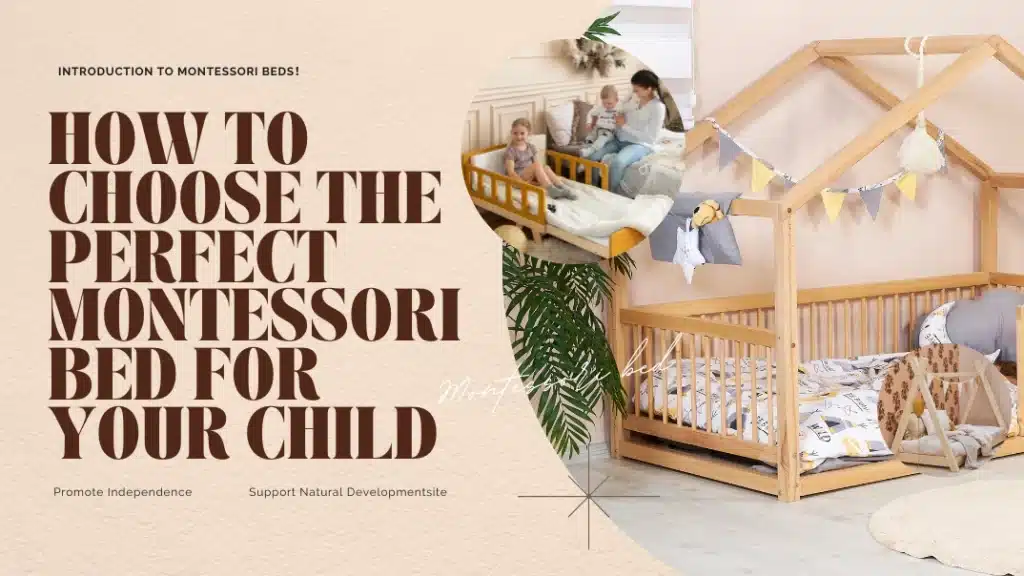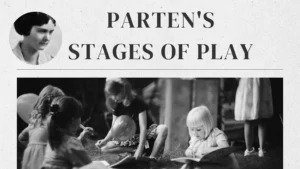They seek the best bed for their little one that promotes independence and aligns with the Montessori philosophy. Montessori beds are an increasingly popular choice among parents who want to create a safe, accessible, child-centered sleep environment. With a Montessori bed, children can explore, play, and develop a sense of autonomy right from their sleeping space.
Choosing the right bed, however, can feel overwhelming. Many options exist, from Montessori floor and house beds to different sizes and styles. In this guide, we’ll cover everything you need to know to select the perfect Montessori bed for your child’s age and development needs. We’ll explore the benefits of beds, compare them with traditional beds, and provide practical advice on choosing the best mattress and accessories to complete the setup.
Whether you’re curious about when to transition to a Montessori bed, how safe they are, or whether a Montessori-style bed is the right fit for your family, this guide covers you. Let’s dive in and discover why Montessori beds are excellent for fostering independence, creativity, and healthy sleep habits in children.

Introduction to Montessori Beds
What is a Montessori Bed?
A Montessori bed is designed to encourage children’s independence and freedom of movement, inspired by the educational philosophy of Maria Montessori. Unlike traditional cribs or elevated toddler beds, They are usually positioned low to the ground, with options such as Montessori floor beds, Montessori toddler beds, and Montessori house beds. This setup allows infants and] children to freely enter and exit their beds, fostering a sense of autonomy.
It comes in several types, including the Montessori floor bed with rails and the Montessori bed frame, which support the child’s need for a safe, accessible sleeping space. These designs are crafted to create a sleep environment that aligns with Montessori principles, emphasizing child-led learning and exploration.
Why Are Montessori Beds on the Floor?
Montessori beds are designed to be placed on the floor to provide children with unrestricted sleep space access. This floor-based setup helps to:
- Promote Independence: By making the bed accessible, even toddlers and babies can get in and out without assistance.
- Enhance Safety: The low height reduces the risk of injury if the child rolls out of bed.
- Support Natural Development: Floor beds allow babies and toddlers to explore their environment safely, encouraging motor skill development.
Historical Context of Montessori Beds
A Montessori bed is rooted in Dr. Maria Montessori’s educational philosophy, which emphasizes a “prepared environment” where children can interact with their surroundings independently. A Montessori baby bed or Montessori infant bed creates a space that respects children’s autonomy, allowing them to explore and develop self-reliance naturally.
| Feature | Montessori Bed | Traditional Bed |
|---|---|---|
| Height | Low to the floor | Elevated |
| Accessibility | Children can freely get in and out | Often requires adult assistance |
| Best Age Range | Suitable from infancy | Generally for 2 years+ |
| Safety | Low fall risk due to height | Needs railings or guards |
| Setup | Requires a child-proofed room | Often contained within the frame |
Benefits of Montessori Floor Beds for Child Development
How Montessori Beds Support Independence
Montessori beds empower children by allowing them to control their sleep environment. With a Montessori bed for toddlers or a Montessori toddler bed that provides entry and exit without assistance, children develop decision-making skills, self-confidence, and self-regulation.
By choosing a Montessori floor bed toddler setup, parents encourage toddlers to explore independence. This autonomy, even at bedtime, supports the Montessori philosophy of fostering growth through safe and structured freedom.
Advantages of Floor Beds for Toddlers and Babies
Using a floor bed Montessori setup brings unique developmental benefits:
- Enhances Motor Skills: With a Montessori floor bed infant or Montessori infant bed, children can crawl, climb, and move freely, strengthening their muscles and coordination.
- Encourages Exploration: A floor-level bed allows toddlers and infants to explore their room independently.
- Establishes Healthy Sleep Habits: When children can get in and out of bed independently, they develop self-discipline and a routine around sleep.
Are Montessori Beds Safe?
Safety is a common concern among parents considering Montessori beds. Montessori beds are safe in a fully child-proofed room and help children develop confidence in their surroundings.
- Low Height: Montessori beds are placed low to the ground, reducing the risk of injury from falls.
- Soft Surroundings: Placing rugs or a Montessori bed bumper around the bed adds extra safety.
- Childproofing: Since children are free to move, childproofing the room ensures safety.
These features make Montessori beds a safe and empowering choice for children’s early years.
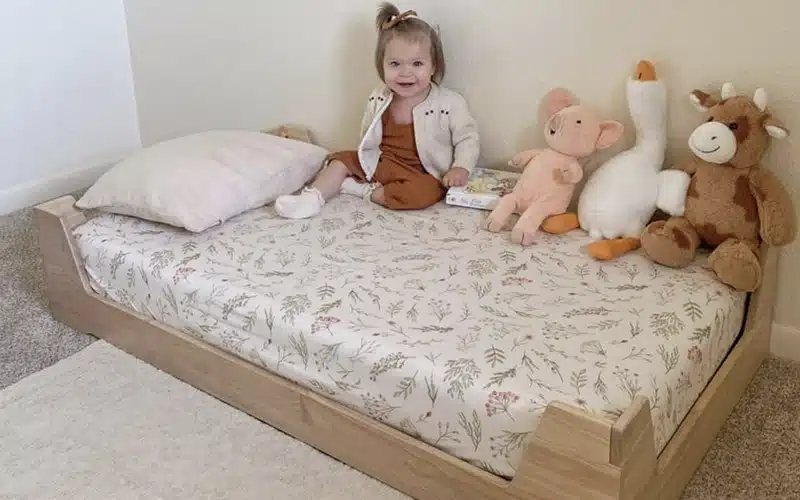
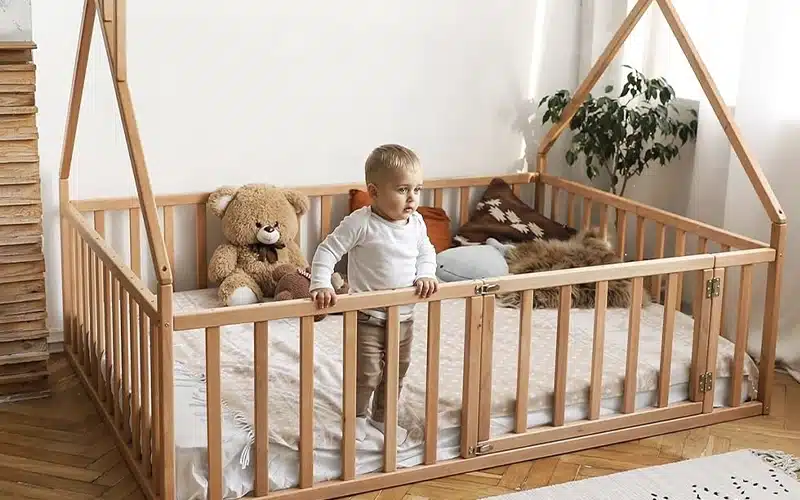
Choosing the Right Montessori Bed for Your Child’s Age
Montessori Bed Age Guide: When to Start and Transition
Parents often wonder when they should transition their child to a Montessori bed. While many parents start around six months, others wait until the child is 18-24. Here’s a guide to the recommended Montessori bed for each age group:
| Age Range | Recommended Bed Type | Key Considerations |
|---|---|---|
| 6-12 months | Crib-size floor mattress | Safe for early exploration |
| 1-2 years | Montessori toddler bed with rails | Combines safety with freedom |
| 2-4 years | Twin-size Montessori bed | Provides space and comfort |
| 5+ years | Full or queen-size Montessori floor bed | Room for growth and family bonding |
Best Montessori Bed Options by Age
Each developmental stage benefits from different types of Montessori beds, supporting children as they grow.
Infants (6-12 Months)
For infants, a Montessori baby bed or a crib-size floor mattress offers a safe space to explore. Babies can practice rolling, crawling, and moving independently without the risk of falling from a height.
Toddlers (1-2 Years)
A Montessori floor bed with rails offers toddlers both safety and freedom. The low rails provide a gentle boundary, preventing accidental rolling out while allowing independence.
Preschoolers (2-4 Years)
Preschoolers enjoy the imaginative design of a Montessori house bed, which resembles a cozy, enclosed space. This bed style adds security and comfort, helping them adjust to a larger sleeping area.
Older Children (5+ Years)
A full-size Montessori bed or a queen Montessori floor bed provides ample space for older children. These more extensive beds are ideal for children who enjoy bedtime stories with their parents or need room for growth.
Types of Montessori Beds and Key Features
Montessori Floor Bed with RailsMontessori
The Montessori floor bed with rails is a popular option for families with toddlers needing containment. The low rails help prevent rolling out of bed, combining the safety of a traditional bed with the independence of a Montessori bed. This setup is ideal for families transitioning from a crib, offering security without restricting movement.
Montessori House Bed and Other Popular StylesMontessori House Bed
The Montessori house bed is a favorite among parents and children alike. A frame shaped like a house creates a cozy, imaginative space that makes bedtime inviting. Other Montessori bed styles include:
- Montessori tent bed: This bed has a tent-like covering, providing privacy and a sense of adventure.
- Montessori bed with storage: Perfect for small spaces, these beds come with drawers for organizing toys or clothes.
Each style supports a child’s developmental needs while creating a unique and engaging sleep environment.
Full-size, Twin, and Queen Montessori Beds
Montessori beds are available in various sizes to suit different needs and room sizes. Here are some options:
- Twin Montessori bed: Ideal for toddlers and young children, providing room for movement.
- Full-size Montessori bed: Great for older children or families who want more space.
- Queen Montessori floor bed: Spacious enough for co-sleeping or growing children needing extra room.
Montessori Bed with Storage
A Montessori bed with storage is ideal for families with limited space. These beds come with built-in drawers, allowing children to access their belongings easily. This setup aligns with Montessori principles, encouraging children to keep their surroundings organized and manageable.
| Montessori Bed Type | Description | Suitable Age Range |
|---|---|---|
| Floor Bed | Simple mattress on the floor; ideal for infants | 6 months+ |
| Montessori Floor Bed with RailsMontessori | Low rails add safety for toddlers | 1-3 years |
| Montessori House Bed | Shaped like a house, it adds comfort and creativity | 2+ years |
| Twin/Full/Queen Montessori Bed | Larger sizes for older children and co-sleeping | 3+ years |
| Montessori Bed with Storage | Under-bed storage drawers, useful for small rooms | 3+ years |
Choosing the Best Mattress and Accessories for a Montessori Bed
Best Mattress for Montessori Floor Beds
Choosing the right mattress for a Montessori floor bed is essential for your child’s comfort, safety, and development. Here are some critical factors to consider:
- Firmness: A firm mattress is ideal for young children, as it provides the necessary support for their developing spine and reduces the risk of suffocation. Firmness is essential for infants using a Montessori baby bed or a Montessori infant bed.
- Hypoallergenic Materials: To create a healthy sleep environment, consider mattresses made from hypoallergenic materials like natural latex, organic cotton, or memory foam. Hypoallergenic materials help prevent allergies, creating a safer and more comfortable space for your child.
- Thickness: A 4–6 inches thick mattress is generally best for Montessori beds. This thickness allows children to easily climb in and out of bed independently, especially if you’re using a Montessori floor bed toddler setup.
- Snug Fit: The mattress should fit snugly within the bed frame, mainly if using a crib-size Montessori floor bed. This ensures no gaps where a child could get trapped, making it safer overall.
Some popular mattress choices for Montessori beds include natural latex for breathability, organic cotton for eco-friendliness, and memory foam for added comfort and support.
Popular Montessori Bed Accessories: Bumpers, Canopies, and Curtains
Adding accessories to a Montessori bed can enhance safety, comfort, and aesthetics. Here are some standard Montessori bed accessories to consider:
- Montessori Bed Bumpers: Soft bumpers are a great addition, especially for toddlers who may roll around in their sleep. Unlike traditional bed rails, bumpers provide a gentle boundary without entirely restricting movement, making them suitable for Montessori beds with rails setups.
- Canopy for Montessori Bed: Adding a canopy creates a cozy, enclosed space to help children feel safe and calm at bedtime. Montessori house beds are especially suited for canopies, as the frame can support curtains or fabric drapes to make the bed more inviting.
- Bed Rails: Low bed rails can be added to a Montessori toddler bed for extra safety, especially if transitioning from a crib. Rails allow for independence while reducing the risk of falls.
- Mattress Protector: A waterproof mattress protector is a practical accessory for Montessori beds, as it helps keep the mattress clean and prolong its lifespan. This is particularly useful for young children who may still have nighttime accidents.
These accessories make the Montessori bed setup practical and enjoyable, providing safety and comfort as children gain independence in their sleep.
Montessori Beds with Storage: Practical Solutions for Small Rooms
A Montessori bed with storage can be valuable for families with limited space. Storage beds come with built-in drawers or shelves under the mattress, which helps keep the room tidy and organized. Here are some practical storage solutions for Montessori beds:
- Under-Bed Drawers: Drawers under the bed provide convenient storage for toys, books, or bedding, helping to keep the room clutter-free and accessible for children.
- Shelving Units: Some Montessori beds have built-in shelving units on the sides, where children can keep their favorite toys or books within reach. This encourages children to take responsibility for organizing their belongings.
- Trundle Bed with Storage: A Montessori bed with a trundle offers storage and extra sleeping space, perfect for sleepovers or families with multiple children sharing a room. The trundle can be tucked away under the bed when not in use, maximizing space.
These storage options help with organization and teach children the importance of a clean and orderly space, a crucial principle in Montessori education.
DIY Montessori Bed Ideas for Parents
How to Build Your Own Montessori BedFor parents who enjoy DIY, building a Montessori bed can be rewarding. Here’s how to get started:
- Gather Materials: Select child-safe wood (like birch or pine), screws, and non-toxic paint.
- Choose a Design: Various Montessori bed plans, including simple floor beds and house-style frames, are available online.
- Assemble the Frame: Use tools to assemble the frame close to the ground, ensuring stability.
- Add Finishing Touches: Sand down rough edges and paint with a non-toxic finish, ensuring the bed is smooth and safe.
A DIY Montessori bed allows parents to customize it to fit their child’s needs and room decor.
Montessori Bed Decoration Ideas
Decorating a Montessori bed adds personality and comfort to the space. Here are some ideas:
- String Lights: Adds a soft glow that creates a calm atmosphere for bedtime.
- Themed Bedding: Select colors and designs that match the child’s interests, like animals or nature.
- Canopy: Adding a canopy to a house bed creates a private, cozy nook that encourages peaceful sleep.
Personalizing the bed can make bedtime more enjoyable for children, encouraging healthy sleep habits.
Pros and Cons of Montessori Beds
Benefits of Montessori Beds
Montessori beds provide several developmental and practical benefits:
- Encourages Independence: Children can manage their sleep routines, building confidence and autonomy.
- Enhances Motor Skills: Floor beds support natural movements like crawling and climbing.
- Suits Minimalist Aesthetics: Montessori beds often have a simple, modern design that fits well with home decor.
Drawbacks of Montessori Beds
While Montessori beds have many benefits, they may not suit every family:
- Requires Child-Proofed Room: Full child-proofing is essential to ensure safety.
- Adjustment Period: Some children may need time to adapt to the openness of a Montessori bed.
- Limited Containment: Parents may prefer the added security of a crib or a traditional bed with high sides.
Montessori Bed vs. Traditional Bed
| Feature | Montessori Bed | Traditional Bed |
|---|---|---|
| Independence | Promotes autonomy and self-regulation | Often requires adult assistance |
| Safety | Low height reduces fall risks | Needs rails or barriers |
| Aesthetic | Simple and modern, suits minimalist decor | Often bulkier |
| Room Setup | Needs a child-proofed environment | Usually contained within the bed structure |
Each bed type offers unique benefits, so it’s essential to consider your child’s needs and family preferences.
Common Questions about Montessori Beds
When to Transition to a Montessori Bed?
Many parents wonder about the best age to transition their child to a Montessori bed. While there’s no strict rule, most families find that transitioning between 6 months and 2 years works well, depending on the child’s development and mobility.
- For Infants (6-12 months): If you choose to transition at this age, a Montessori infant bed (like a crib-sized floor mattress) is ideal, allowing babies to explore safely while reducing fall risks.
- For Toddlers (1-2 years): Toddlers at this age are usually ready for more freedom. A Montessori toddler bed with low rails or a Montessori floor bed with rails can be a safe and supportive choice as they transition out of a crib.
Starting with a floor bed, Montessori setup early allows children to grow with the bed, helping them develop a natural sense of independence and comfort in their sleep environment.
Why Are Montessori Beds So Popular Among Parents?
Montessori beds are increasingly popular among parents because they align with many modern parenting values, focusing on independence, safety, and respect for the child’s natural development.
- Promotes Independence: A Montessori bed on the floor gives children the freedom to get in and out of bed independently. This autonomy helps build self-confidence and teaches them to manage their sleep habits.
- Safety and Accessibility: With a Montessori floor bed, the low height minimizes the risk of falls, making it safer for young children. Parents often choose a Montessori bed frame full or crib-size Montessori floor bed to provide a safe, low-access sleep environment.
- Supports Montessori Philosophy: The Montessori-style bed is not just a place to sleep—it’s part of the Montessori method that encourages self-directed activity and hands-on learning.
For these reasons, Montessori beds appeal to parents who value a child-centered approach, aiming to provide an environment where their child can thrive.
Are Montessori Beds Right for Every Family?
While Montessori beds offer many benefits, they may not suit every family. Here are a few factors to consider:
- Space and Room Setup: A Montessori floor bed toddler setup requires a fully child-proofed room since the child has free access to their surroundings. Families with limited space might struggle to maintain a safe, accessible environment.
- Adjustment Period: Some children adjust to the openness of a Montessori bed. Unlike traditional cribs, Montessori floor beds have no high sides, which can initially be unsettling for some children. A Montessori bed bumper or Montessori bed with rails can add some security during this transition period.
- Family Preferences: While Montessori beds promote independence, some families may prefer traditional cribs or toddler beds with higher railings for added containment, especially if the child’s room cannot be fully child-proofed.
Ultimately, the choice depends on the family’s space, lifestyle, and parenting approach. Montessori beds work best in homes that value independence, freedom of movement, and child-centered learning, but they might not be ideal for families with specific safety or space concerns.
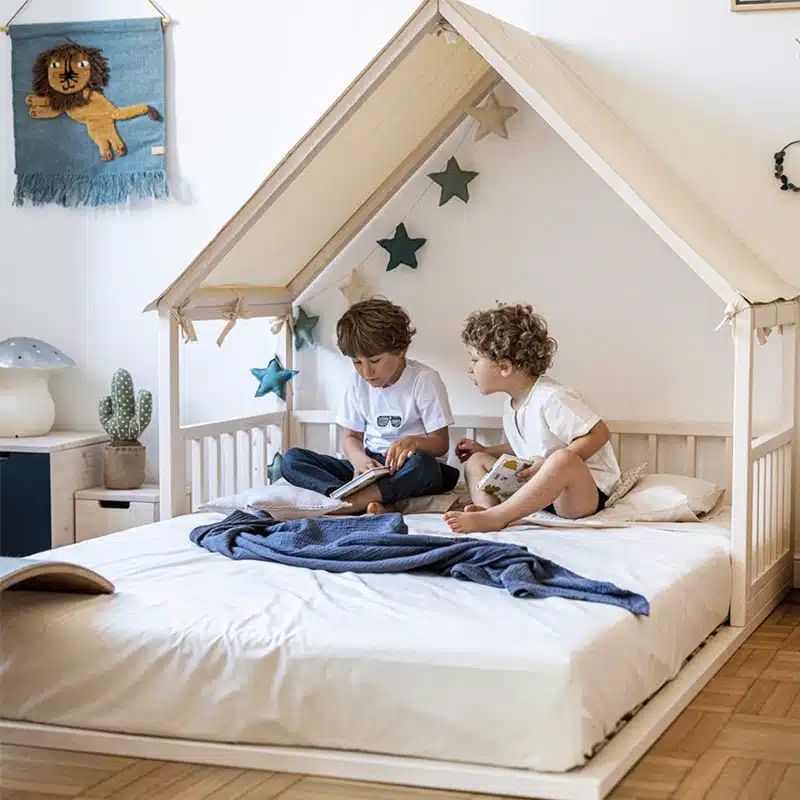
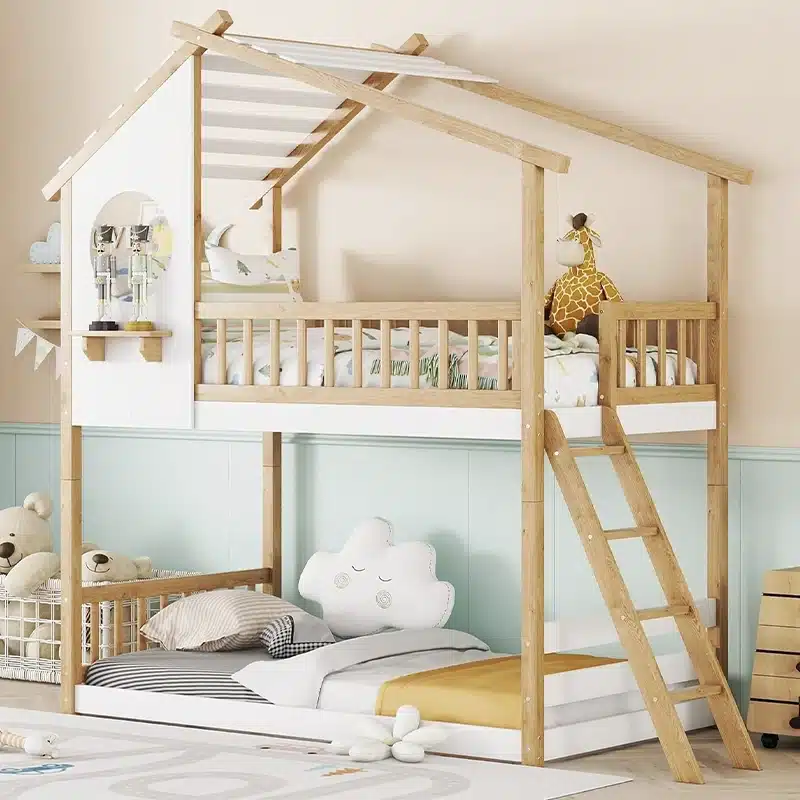
Choosing the right Montessori bed for your child can make a meaningful difference in their growth, independence, and overall sleep experience. Montessori beds, whether floor beds, house beds, or beds with storage, are designed to give children the freedom to explore, play, and rest independently, all within a safe and accessible environment.
By considering factors like your child’s age, developmental needs, and the space available in your home, you can select a Montessori bed that best supports their journey towards self-reliance. Choosing the ideal mattress and adding thoughtful accessories such as bumpers, canopies, or under-bed storage can further personalize the bed, making it functional and enjoyable for your child.
Montessori beds are more than just a place to sleep—they invest in your child’s independence, confidence, and a lifelong love of learning. With the right bed, you provide a comfortable sleep space and a foundation for exploration, creativity, and healthy development.

